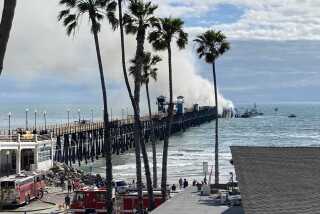Price for Protection of Mono Lake: 10% of L.A. Water Supply
Los Angeles would have to give up about 10% of its available water supply to preserve the present level of Mono Lake, threatened by water diversions to the city, a group of scientists reported Wednesday.
Their report, prepared for the state Assembly, provides the most precise projection so far of how much Los Angeles would have to pay--in higher water bills and in loss of water supply--to protect the rare birds, shellfish and stark volcanic-like scenery of the 500,000-year-old saline lake, located in the Sierra Nevada 300 miles northeast of the city.
Duane Georgeson, assistant general manager of the Los Angeles Department of Water and Power, said he agreed with the estimates of the Community and Organization Research Institute of UC Santa Barbara.
The report, “The Future of Mono Lake,” warned that if Los Angeles continues to divert water in present amounts from the High Sierra creeks that empty into the lake, “the existing lake ecosystem could cease to function by 2012.”
This is the second such report in the last year on the threat to the lake. The first, by an arm of the National Academy of Sciences, was designed to guide federal water policy makers as they decide on the best way of saving the lake. The aim of the UC study is to help the Legislature and state agencies as they take up the same task.
Under increasing pressure from environmentalists, both federal and state officials have been concerned about the future of the lake, which has been shrinking since Los Angeles began water diversions in l941. The five streams that feed the lake, combined with water from the Owens Valley just to the south, provide the bulk of the city’s water supply. The rest comes from Northern California, the Colorado River and local wells.
The latest report is noteworthy because it spells out just how much Sierra water the city would lose to preserve the lake level, according to the study’s principal investigator, Daniel B. Botkin, professor of biology and environmental studies at UC Santa Barbara.
At present, the report notes, Los Angeles draws about 90,000 acre-feet a year from the mountain creeks. An acre-foot is equivalent to water needed to cover an acre one foot deep--about the amount needed for a year by a family of five with a house and yard.
Suggested Level
Based on an analysis of historic lake levels, the scientists projected that by next year, the lake will have lowered enough to expose a land bridge between the shore and a major island breeding place for migratory birds. By 1994, vegetation needed for the lake’s ecosystem would go and in another five years the lake would be too salty for the brine shrimp, a rare variety that is eaten by migratory birds.
The report said that if the surface of the lake, now at an elevation of 6,378 feet, were maintained at 6,382 feet, “key features of the lake ecosystem and most scenic attributes will be protected, although there will be some erosion of the tufa towers,” which are distinctive rock formations in the lake.
But that would require a reduction of 42% of the average amount the city has taken from the nearby streams. That, Botkin said, means a 10% reduction of the amount of water available to the city.
Both Botkin and the DWP said it would cost the city $23 million to buy water to make up the loss. It would come from the Metropolitan Water District’s Colorado River supply. In addition, the city would lose $10 million a year that it now earns from the sale of power generated by the water as it travels to Los Angeles in an aqueduct.
Environmentalists have said these replacement cost estimates are too high. And some environmental groups have said that the figures do not take into consideration the amount of water that could be saved in the city by conservation.
The study said that if the lake were maintained at a lower level--6,372 feet--the city would lose only 6.7% of its water supply.
But it said “a significant number of the tufa towers would be endangered, the breeding biology of the snowy plover (which nests at the lake) would be endangered and a portion of the existing wetlands would be threatened with drainage.”
Los Angeles would lose only 4.2% of its available water if the lake level went down to 6,362 feet. But “the production of brine flies and brine shrimp would be reduced to the point where bird populations could no longer be supported.”
More to Read
Start your day right
Sign up for Essential California for news, features and recommendations from the L.A. Times and beyond in your inbox six days a week.
You may occasionally receive promotional content from the Los Angeles Times.






